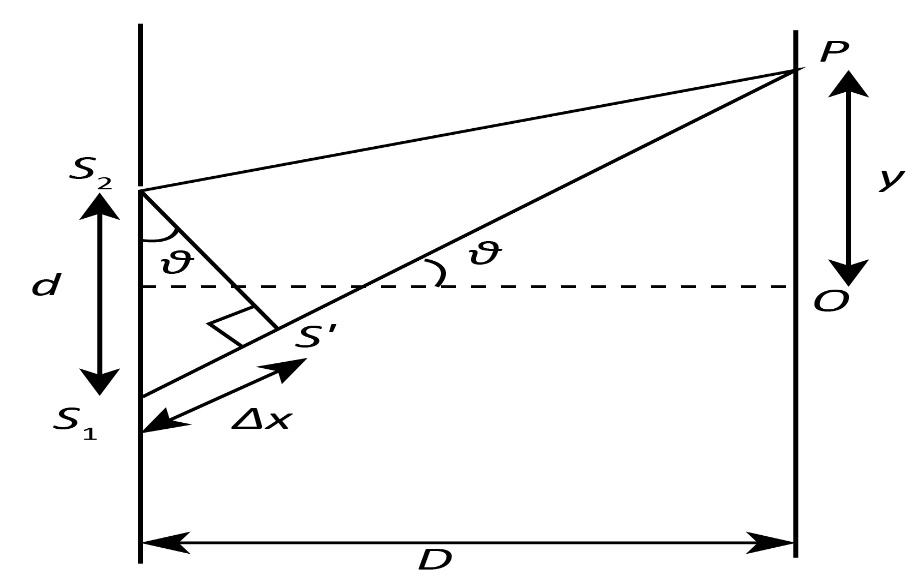
In Young's double slit experiment the distance of the nth dark fringe from the centre is:
(A) $n\left( {\dfrac{{\lambda D}}{{2d}}} \right)$
(B) $n\left( {\dfrac{{2D}}{{\lambda d}}} \right)$
(C) $\left( {2n - 1} \right)\left( {\dfrac{{\lambda D}}{{2d}}} \right)$
(D) $\left( {n - 1} \right)\left( {\dfrac{{4D}}{{\lambda d}}} \right)$
Answer
567.6k+ views
Hint: First, we can explain the structural set up of Young’s double slit experiment. Then, using the condition to obtain a dark fringe, we can find the solution.
Complete step by step answer:Let us consider the diagram below showing Young’s double slit experiment. Let ${S_1}$ and ${S_2}$ are the slits through which the monochromatic light of wavelength$\lambda $ is passed. Let $d$ be the distance between the slits and $D$ be the distance from the plane of the slits to the screen where the fringes are formed. We can take $y$ as the distance from the centre $O$ of the screen to the point $P$. Consider that the light waves coming out of the slits ${S_1}$ and ${S_2}$ interfere destructively at the point $P$. A dark fringe is formed when there is a destructive interference of the waves. We assume that the ${n^{th}}$ dark fringe is formed at the point $P$.

Now, the path difference of the waves can be written as
$\Delta x = {S_2}P - {S_1}P$
From the , we get
$\sin \theta = \dfrac{{\Delta x}}{d}$
Here $\theta $ is the angular position of the ${n^{th}}$ dark fringe.
Hence, we can write
$\Delta x = d\sin \theta $
Again, from the figure, we can write
$\sin \theta = \dfrac{y}{D}$
We can substitute $\dfrac{y}{D}$ for $\sin \theta $ in the equation $\Delta x = d\sin \theta $. Then,
$\begin{array}{c}
\Delta x = \dfrac{{dy}}{D}\\
\Rightarrow y = \dfrac{{\Delta xD}}{d}
\end{array}$
In Young’s double slit experiment, the condition to obtain a dark fringe can be written as
$\Delta x = \left( {2n - 1} \right)\dfrac{\lambda }{2}$
Now, we can use this condition in the equation $y = \dfrac{{\Delta xD}}{d}$. Therefore, we get
$y = \left( {2n - 1} \right)\dfrac{\lambda }{2}\dfrac{D}{d}$
So, the distance of the ${n^{th}}$ dark fringe from the centre is $\left( {2n - 1} \right)\dfrac{\lambda }{2}\dfrac{D}{d}$. Therefore, the option.
Note:We can get confused with the conditions for obtaining a bright fringe and a dark fringe. For obtaining a bright fringe, the path difference should be an integer multiple of the wavelength of light.
Complete step by step answer:Let us consider the diagram below showing Young’s double slit experiment. Let ${S_1}$ and ${S_2}$ are the slits through which the monochromatic light of wavelength$\lambda $ is passed. Let $d$ be the distance between the slits and $D$ be the distance from the plane of the slits to the screen where the fringes are formed. We can take $y$ as the distance from the centre $O$ of the screen to the point $P$. Consider that the light waves coming out of the slits ${S_1}$ and ${S_2}$ interfere destructively at the point $P$. A dark fringe is formed when there is a destructive interference of the waves. We assume that the ${n^{th}}$ dark fringe is formed at the point $P$.

Now, the path difference of the waves can be written as
$\Delta x = {S_2}P - {S_1}P$
From the , we get
$\sin \theta = \dfrac{{\Delta x}}{d}$
Here $\theta $ is the angular position of the ${n^{th}}$ dark fringe.
Hence, we can write
$\Delta x = d\sin \theta $
Again, from the figure, we can write
$\sin \theta = \dfrac{y}{D}$
We can substitute $\dfrac{y}{D}$ for $\sin \theta $ in the equation $\Delta x = d\sin \theta $. Then,
$\begin{array}{c}
\Delta x = \dfrac{{dy}}{D}\\
\Rightarrow y = \dfrac{{\Delta xD}}{d}
\end{array}$
In Young’s double slit experiment, the condition to obtain a dark fringe can be written as
$\Delta x = \left( {2n - 1} \right)\dfrac{\lambda }{2}$
Now, we can use this condition in the equation $y = \dfrac{{\Delta xD}}{d}$. Therefore, we get
$y = \left( {2n - 1} \right)\dfrac{\lambda }{2}\dfrac{D}{d}$
So, the distance of the ${n^{th}}$ dark fringe from the centre is $\left( {2n - 1} \right)\dfrac{\lambda }{2}\dfrac{D}{d}$. Therefore, the option.
Note:We can get confused with the conditions for obtaining a bright fringe and a dark fringe. For obtaining a bright fringe, the path difference should be an integer multiple of the wavelength of light.
Recently Updated Pages
Master Class 12 English: Engaging Questions & Answers for Success

Master Class 12 Business Studies: Engaging Questions & Answers for Success

Master Class 12 Economics: Engaging Questions & Answers for Success

Master Class 12 Social Science: Engaging Questions & Answers for Success

Master Class 12 Maths: Engaging Questions & Answers for Success

Master Class 12 Chemistry: Engaging Questions & Answers for Success

Trending doubts
What are the major means of transport Explain each class 12 social science CBSE

Which are the Top 10 Largest Countries of the World?

Draw a labelled sketch of the human eye class 12 physics CBSE

Explain sex determination in humans with line diag class 12 biology CBSE

The pH of the pancreatic juice is A 64 B 86 C 120 D class 12 biology CBSE

Explain sex determination in humans with the help of class 12 biology CBSE




